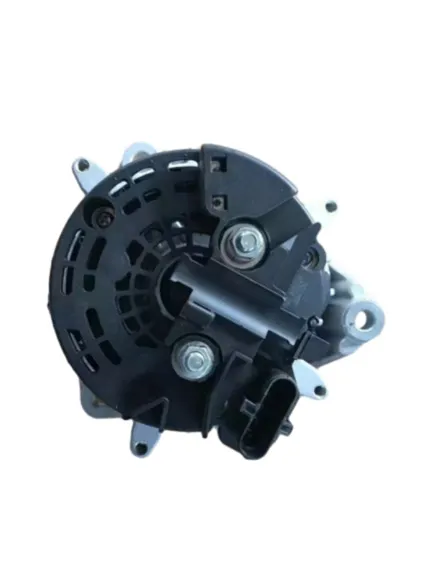The question arrives on the wind like a quiet spark: where is Jinlitong Automobile Alternator Manufacturing Plant located? It’s a query that feels simple on the surface, yet unfurls into a map of considerations, a tapestry of logistics, labor, and landscape. To answer it, one must picture not just a street address, but a geography of possibility. A plant’s location is less a point on a line and more a conversation with weather, water, rails, and roads; with workers who arrive with mornings and ambitions; with the rhythms of nearby towns that pulse with commerce and memory.

Imagine stepping into a dawn that smells faintly of oil and ozone, where the air carries the quiet hum of forklifts and the softer murmur of distant markets. A plant that makes automobile alternators—vital little dynamos that breathe life into engines—needs a place where parts can flow in and energy can flow out. The location must be accessible to suppliers who provide copper windings and springs, to the foundries that shape metal, to the assembly lines that stitch components into a dependable heartbeat for a vehicle. It’s a balancing act, a choreography that seeks efficiency without sacrificing resilience.
Geography matters, of course. A region with robust road networks can reduce the time from supplier to line and from finished product to customer. Proximity to ports can cut down on the cost and risk of international shipments, the kind of logistical nuance that can tilt a decision from viable to optimal. And there’s the matter of climate: a temperate zone invites steady operations; a place with clean energy options can support sustainable production, an increasingly valued credential in the eyes of partners and communities alike. The plant’s whisper-quiet machines don’t just need power; they need predictability—stable electricity, predictable weather, reliable carriers.
Then there is the human geography—the life that quietly orbits the factory gates. The neighborhood around a plant becomes a living partner in the enterprise. Schools who produce apprentices with the right blend of curiosity and dexterity. Local vendors who know the rhythm of early shifts and late deliveries. A workforce that chooses to stay because the plant’s presence has become part of the town’s own story. The location becomes not only about where the machines are built, but about where people build their lives, day by day, shift by shift, laugh by lunch break.

For Jinlitong, let’s imagine a setting that harmonizes these threads. Picture a corridor of manufacturing towns where rail tracks hum with steady freight, where a river offers a natural, renewable heartbeat, and where a cluster of suppliers has grown up in the shadow of similar enterprises. This isn’t a single street or a single city; it’s a constellation of logistics nodes that together support a production system. The plant’s location, in this vision, becomes a node that links raw materials to finished alternators with the quiet tempo of a well-rehearsed orchestra. The gears turn in unison with the region’s tradition of precision engineering, a lineage that stretches back through decades of craftsmanship and industrial evolution.
Yet the question remains, at least to the curious reader who stares at a map and feels the tug of curiosity: is Jinlitong’s plant publicly disclosed? In the world of complex supply chains, not every location is laid bare for every eye. Some data sits behind corporate disclosures, investor decks, and official filings; other layers remain part of the company’s strategic narrative. The absence of a street address on a brochure doesn’t diminish the significance of the story, it invites a broader contemplation of how and why such a plant comes to anchor itself where it does.
In the soft glow of this exploration, we watch the choreography of place unfold through a few scenes. A logistics expert sits with a tablet, tracing routes on a digital map, pointing to corridors where trucks glide through at dawn and dusk. A factory manager describes the balance between proximity to suppliers and the costs of utilities, the delicate calculus that underpins every location decision. A community organizer speaks of apprenticeship programs, of partnerships between schools and the plant that light up future pathways for young people. A driver at a nearby loading dock shares a moment of camaraderie with a maintenance technician, both of them aware that their days hinge on the steady pulse of a clock and a conveyor belt.

All of this—these textures of place—feeds into the larger narrative: a plant isn’t just a building; it’s a heartbeat that connects a company to a region, to a supply network, to the people who sustain it. The question “Where is Jinlitong located?” becomes less a quest for a coordinate and more a meditation on how location shapes possibility, fuels trust, and kindles the sense that a single facility can influence many lives beyond its walls. The map invites us to imagine the unseen threads—the energy grid that keeps the lines alive; the training programs that cultivate expertise; the relationships with vendors that ensure quality and continuity.
As we close Part 1, we carry a sense of anticipation rather than certainty. The exact plaza or province may be veiled, yet the themes that anchor Jinlitong’s choice are legible: accessibility and reliability, a respectful dialogue with the surrounding community, and a commitment to sustainable practice that respects both the environment and the people who contribute to the plant’s day-to-day vitality. The question persists, and with it the invitation to consider how a location becomes a promise kept across a supply chain.
If Part 1 wandered softly through the idea of place, Part 2 steps closer to the living reality that a location implies—the everyday routines, the environmental conscience, the economic ripple, and the personal stories of people who show up to work each morning with a shared intention: to keep the car alive, to keep motion steady, to keep a promise of reliability for drivers who count on their vehicles.

A plant’s location shapes its rhythms. The start of a shift is a social moment as much as a logistical one: a crowd of faces arriving with coffee cups, ID badges, and the unspoken pact that today’s production will meet the standards that the brand has set. The surrounding community is not a backdrop; it’s a partner whose feedback, aspirations, and concerns color decisions from day to day. When a plant sits in a corridor that has schools, transit lines, and environmental initiatives, its employees find it easier to see their work as part of a bigger story—one that values skill, safety, and stewardship.
The social climate around Jinlitong’s hypothetical location would likely include a tapestry of programs designed to attract, train, and retain workers. Apprenticeships, vocational programs, and hands-on training at nearby technical schools become a supply chain for talent just as essential as copper windings or bearing assemblies. On the factory floor, mentors pair with new arrivals to build not only the accuracy of a component but the confidence of a professional. The work is precise, yes, but the human element—the conversations shared during breaks, the collaborative problem-solving when a tool misbehaves, the collective pride after a successful audit—these are the threads that hold the fabric together.
Sustainability is another thread that runs through a modern factory’s story. A location with access to clean energy and an efficient waste management system becomes a canvas for responsible practice. Water stewardship, energy efficiency, and emissions reduction aren’t abstract goals; they are living programs, visible in how a plant codes its energy use, how it manages its waste streams, and how it engages with the local environment. In a world increasingly sensitive to climate considerations, the plant’s footprint matters as much as its output. Communities monitor groundwater health, air quality, and noise levels with a practical, constructive eye; the plant, in response, adapts, tunes, and innovates.

The economic ripple is tangible as well. A manufacturing site attracts suppliers, service providers, and logistics partners. It can become a magnet for small businesses—a local machine shop that completes a precision part, a courier service that supports overnight delivery, a café that becomes a after-work refuge for engineers and drivers alike. When the plant thrives, a geography of opportunity grows around it. During peak seasons, demand might surge; the region learns to flex, to partner, to scale up. When that happens, the city or province absorbs the energy of growth with a pragmatism that feels almost inevitable: schools adjust course offerings, housing markets respond with new listings, and municipal planners weave in corridors for new transit lines or improved roadways.
In this imagined yet plausible frame, Jinlitong’s plant becomes more than a node in a circuit; it becomes a small universe where people converge to produce something that travels far beyond its gates—alternators that spark life into engines, that power dashboards and fans, that support the quiet reliability a driver depends on. The location informs the story of reliability in motion: not just the reliability of metal and magnetism, but the reliability of a relationship—between company and community, between supplier and customer, between workers who leave each morning with a sense of purpose and return to their families with largely the same sense of purpose tempered by the day’s learning.
If you’re curious about the exact coordinates of Jinlitong’s facility, this piece won’t hand you a street address. Real-world answers sit in formal channels—corporate communications, official registries, and press materials that disclose the plant’s footprint under the governance of the company and the regulatory environment in which it operates. Yet the value of the location question endures precisely because it invites us to consider what a plant represents: a nexus where design meets execution, where market needs meet human potential, and where the choice of place becomes a quiet endorsement of a company’s values.
In closing, the journey around the question “Where is Jinlitong Automobile Alternator Manufacturing Plant located?” isn’t just about geography. It’s about the way a location frames possibility, how it shapes the lives of people who work there, and how it becomes a partner to the communities that host it. The exact pin on the map may remain somewhere between rumor and policy, but the larger story—about balance, responsibility, and the steady work that keeps the world moving—is clearer than ever. If you want a precise address, the best route is to look to official channels: the company’s own disclosures, investor relations communications, and regulatory filings. In the end, those sources contextualize the place within a broader conversation about how modern manufacturing meets the needs of today’s world while staying mindful of tomorrow’s responsibilities.
Alternator With multiple core patented technologies and rigorous quality control systems (such as 9001 certification), we have established long-term partnerships with over 300 automotive manufacturers and component suppliers worldwide. Our products are exported to countries such as Europe, America, Southeast Asia, and Africa, with an annual production capacity exceeding 300000 units. We have won market trust with stable delivery and after-sales support.